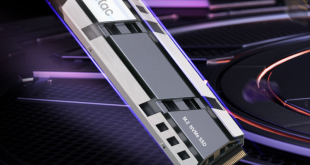The Gigabyte X79S-UP5 WIFI arrives in a predominately white box, which is covered in information on all sides.
The bundle is extensive and contains SATA cables, a backplate, two wireless transmitters, SLI (2 and 3 way) and Crossfire connectors, wireless card, software discs and user manuals. There is also a 3.5 inch USB 3.0 drive bay and a Gigabyte sticker for a chassis.
The X79S-UP5-WIFI is built around a black PCB with blue accenting on the heatsinks. It is a well designed E-ATX board measuring 30.5 cm x 26.4 cm.
The board comprises some large heatsinks to help cool the chipset, these are all colour coordinated around the CPU socket and close to the SATA ports at the bottom of the board.
There is a manual power switch set close to the memory slots. There are eight 1.5v DDR3 DIMM sockets on the board, which support up to 64GB of system memory.
Obviously we don't advise you install a 32 bit OS as this will be limited. As an X79 board, this is obviously a QUAD channel architecture and it supports 1066mhz, 1333mhz, 1600 mhz, 1866 mhz, and 2133 mhz memory out of the box. It also supports ECC memory modules. As we would expect Extreme Memory Profiles (XMP) are supported.
There are several fan headers close to the CPU socket, and an 8 pin power connector close to the upper most heatsink (image above).
The X79S-UP5-WIFI supports 3 way SLI and 3 way Crossfire. 2 of the slot run at x16 bandwidth (PCIEX16_1 and PCIEX 16_2). For optimum performance, if only one PCI Express graphics card is to be installed, be sure to install it in the PCIEX16_1 slot; if you are installing two PCI Express graphics cards, it is recommended that you install them in the PCIEX16_1 and PCIEX16_2 slots.
There are two other PCI Express x16 slots, one running at x8 bandwidth, the other x4 bandwidth. The PCIEX8 slot shares bandwidth with the PCIEX16_2 slot. When the PCIEX8 slot is populated, the PCIEX16_2 slot will operate at up to x8 mode. There is also a PCI Express x1 slot and a single PCI Slot.
The grey ports on the left of the image above are SAS2 connectors. The black ports are SATA 2 – 3Gbps rated. The two white ports at the far right at SATA 3 – 6Gbps rated.
The SAS connectors are controlled by the Intel C606 chipset, each SAS connector supports a single SAS or SATA drive. The Intel C606 chipset supports Raid 0, 1 and 10. The SATA 3Gbps and 6Gbps connectors are also controlled by the Intel C606 chipset and can be configured into Raid 0, 1, 5 and 10.
Along the bottom of the board, is an audio connector, close to an 1394 connector and fan header. There are several USB headers before we come to the front panel header, right next to an emergency reset switch.
It would have made more sense to position the reset switch at to the top of the board, next to the power switch. Graphics cards and other slot based components can partially cover the lower section of the board.
Another fan header is positioned beside the SATA and SAS headers.
The back Panel connectors are:
- 1 x PS/2 keyboard/mouse port
- 1 x CPU overclocking button
- 1 x BIOS switch button
- 1 x Clear CMOS button
- 1 x IEEE 1394a port
- 4 x USB 3.0/2.0 ports
- 5 x USB 2.0/1.1 ports
- 1 x eSATA/USB Combo connector
- 1 x eSATA 6Gb/s connector
- 2 x RJ-45 ports
- 1 x optical S/PDIF Out connector
- 5 x audio jacks (Center/Subwoofer Speaker Out, Rear Speaker Out, Line In, Line Out, Mic In)
We appreciate the inclusion of a BIOS switch, clear CMOS and overclocking button.
 KitGuru KitGuru.net – Tech News | Hardware News | Hardware Reviews | IOS | Mobile | Gaming | Graphics Cards
KitGuru KitGuru.net – Tech News | Hardware News | Hardware Reviews | IOS | Mobile | Gaming | Graphics Cards


















That is one insane motherboard. very impressive featureset. not that expensive either, I was factoring in £400 before I got to the conclusion.
That GSKILL ares memory looks like it was made for the board.
Good results, not for me, but I can appreciate the workstation desire for this. over £1,000 for the chip puts it firmly in the market for rendering and video work.
Shame they cant be overclocked, but I see their more expensive Xeon’s cost quite a bit extra so wouldnt make much sense for them logistically.
These are great chips. they will always be locked out. the pro market doesn’t want unlocked chips, instability ALWAYS occurs with overclocking.
Still I understand your point. would be nice to see performance at 4.5ghz. would be interested myself to see the headroom. 8 cores might heat up more than the 6 core 3960 and 3930. although im sure 4.5ghz would be possible with the H100.
mega review Zardon – ive always loved Xeon processors. we adopted 6 of the new E5 2670 in our business for the network and serving clients.
Our IT guys are always singing their praises for being 100% solid. personally im not into overclocking so id be happy with one of these, if I could justify the cost. 3930 is next on my list, but ill run it stock speeds.
Is the C606 chipset also suitable for a normal non-xeon build? I am planning on using this board for a future build since it is cheaper than most high-end X79 board, and I don’t really trust the first generation of X79 boards.
This board works with 2011 slot processors, including the 3930 and 3960, yes.